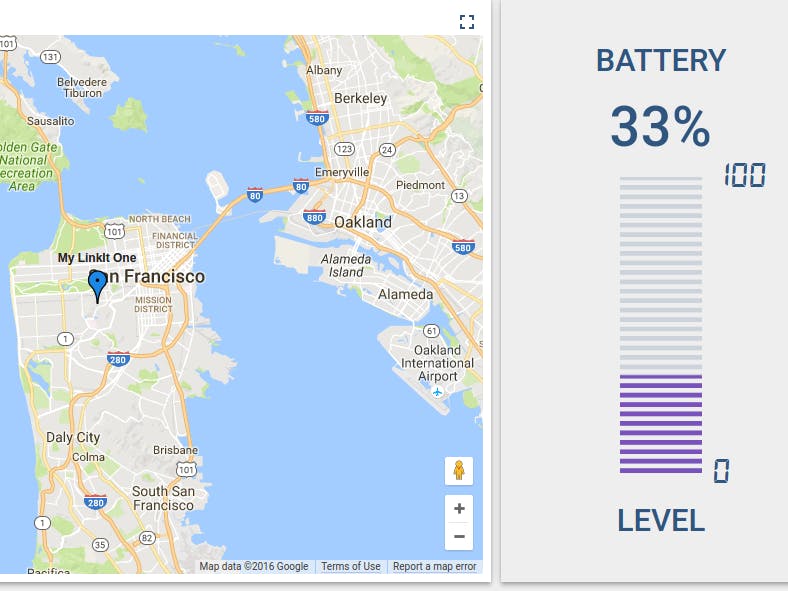This sample application shows capability to track GPS location of LinkIt ONE device and further visualization on the map. It performs collection of latitude and longitude values produced by GPS module. Collected data is pushed to Thingsboard for storage and visualization. The purpose of this application is to demonstrate Thingsboard data collection API and visualization capabilities.
The GPS module is built-in module of LinkIt ONE. LinkIt ONE pushes data to Thingsboard server via MQTT protocol by using PubSubClient library for Arduino. Data is visualized using map widget which is part of customizable dashboard. The application that is running on LinkIt ONE is written using Arduino SDK which is quite simple and easy to understand.
Once you complete this sample/tutorial, you will see your device GPS and battery data on the following dashboard.
You will need to Thingsboard server up and running. Use either Live Demo or Installation Guide to install Thingsboard.
This tutorial was prepared for Windows OS users. However it is possible to run it on other OS (Linux or MacOS).
Thingsboard configurationNote Thingsboard configuration steps are necessary only in case of local Thingsboard installation. If you are using Live Demo instance all entities are pre-configured for your demo account. However, we recommend to review this steps because you will still need to get device access token to send requests to Thingsboard.
Provision your deviceThis step contains instructions that are necessary to connect your device to Thingsboard.
Open Thingsboard Web UI (http://localhost:8080) in browser and login as tenant administrator
- login: tenant@thingsboard.org
- password: tenant
Goto “Devices” section. Click “+” button and create device with name “LinkIt One Demo Device”.
Once device created, open its details and click “Manage credentials”.
Copy auto-generated access token from the “Access token” field. Please save this device token. It will be referred to later as $ACCESS_TOKEN.
Click “Copy Device ID” in device details to copy your device ID to clipboard. Paste your device ID to some place, this value will be used in further steps.
Provision your dashboardDownload the dashboard file using this link. Use import/export instructions to import the dashboard to your Thingsboard instance.
Programming the LinkIt One deviceIf you already familiar with basics of LinkIt One programming using Arduino IDE you can skip the following step and proceed with step 2.
Step 1. LinkIt ONE and Arduino IDE setup.In order to start programming LinkIt One device you will need Arduino IDE installed and all related libraries. Please follow this guide in order to install the Arduino IDE and LinkIt One SDK:
It’s recommended to update your firmware by following this guide. To try your first LinkIt One sample, please follow this guide.
Step 2. PubSubClient library installation.Open Arduino IDE and go to Sketch -> Include Library -> Manage Libraries. Find PubSubClient by Nick O’Leary and install it.
Note that this tutorial was tested with PubSubClient 2.6.
Download and open gps_tracker.ino sketch that is attached to this article.
Note You need to edit following constants and variables in the sketch:
- WIFI_AP - name of your access point
- WIFI_PASSWORD - access point password
- WIFI_AUTH - choose one of LWIFI_OPEN, LWIFI_WPA, or LWIFI_WEP.
- TOKEN - the $ACCESS_TOKEN from Thingsboard configuration step.
- thingsboardServer - Thingsboard HOST/IP address that is accessable within your wifi network. Specify “demo.thingsboard.io” if you are using live demo server.
Connect your LinkIt One device via USB cable and select Serial Debug COM port in Arduino IDE. Compile and Upload your sketch to device using “Upload” button.
After application will be uploaded and started it will try to connect to Thingsboard node using mqtt client and upload “latitude” and “longitude” attributes once per second.
TroubleshootingWhen application is running you can connect your device to Serial Debug COM port in Arduino IDE and open “Serial Monitor” in order to view debug information produced by serial output.
Data visualizationFinally, open Thingsboard Web UI. You can access this dashboard by logging in as a tenant administrator. Use
- login: tenant@thingsboard.org
- password: tenant
In case of local Thingsboard installation.
Go to “Devices” section and locate “LinkIt One Demo Device”, open device details and switch to “Attributes” tab. If all is configured correctly you should be able to see “latitude”, “longitude” and battery status attributes and theirs latest values in the table.
After, open “Dashboards” section then locate and open “LinkIt One GPS Tracking Demo Dashboard”. As a result you will see the map widget with pointer indicating your device location and battery level widget (similar to dashboard image in the introduction).





Comments
Please log in or sign up to comment.